About
The BMS allows breeders to group lines by assigning a Group ID to a line and its descendants. Grouping lines is particularly important in hybrid breeding programs. In a typical hybrid breeding program when a line is considered homozygous, either by inbreeding or doubled haploid formation, it is marked as ‘fixed’ and given a code name.
Fixed Inbred Lines
Group ID can be used to identify a fixed inbred line and all descendants. A line that has reached fixation is expected to give rise to genetically identical offspring through maintenance breeding methods. When an inbred line is deemed "fixed" it can be grouped, so that all descendants, even those with different breeding histories and GIDs, can be retrieved by searching Group ID. At any point in the breeding process, descendants can be regrouped. For example, inbred line resulting from pedigree breeding will not be 100% homozygous. Offspring with off-type phenotypes can be regrouped to distinguish from non-segregating lines.
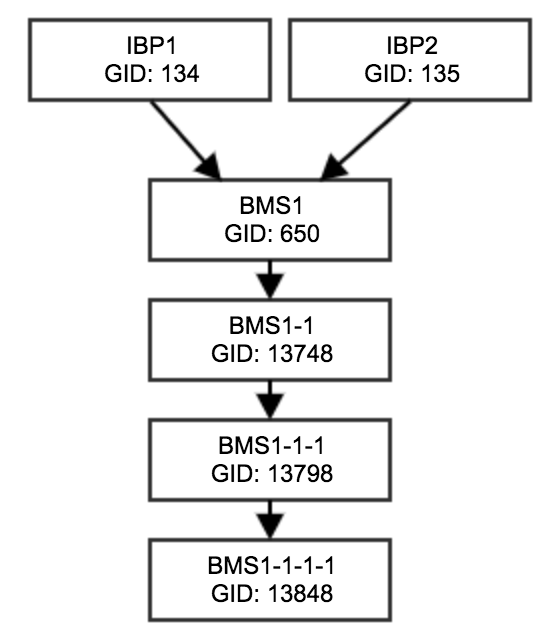
BMS1-1-1-1 is an F4, which has homozygosity estimated at ~87.5%. This estimate can be presumed higher for traits of interest if selection was applied during line development. A breeder might consider F4 lines as fixed and want to keep track of descendants.
- From Manage Germplasm list view, select lines to fix. Mark lines as fixed from the Coding & Fixing Options of the actions menu.
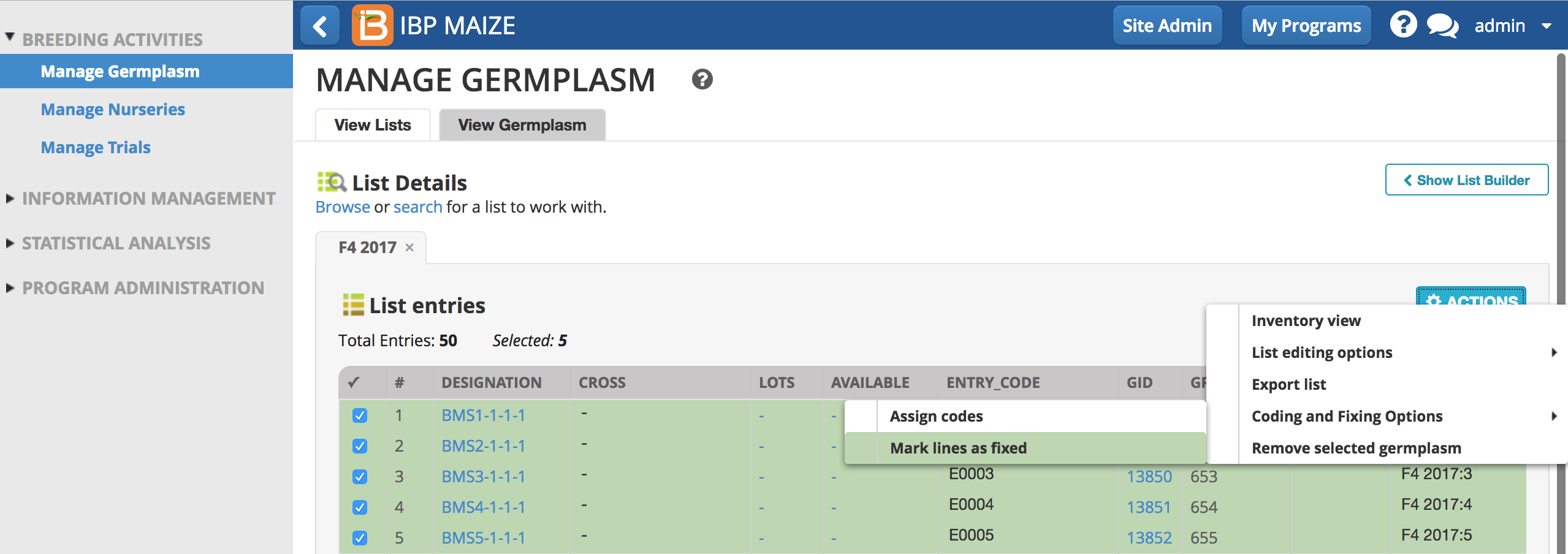
Preserve Existing Group
If checked, preserve existing group will preserve the any existing Group ID. If unchecked this line will assign a new Group ID, allowing you to re-group previously grouped lines. For example, if the originally grouped line was not truly fixed and more lines of purification (inbreeding) were needed, re-grouping is permitted.
Include Descendants
Under most circumstances you will want your group to include descendants of the line in the group, but you may chose to not include descendants if the line you are grouping has already been advanced.
- Include descendants in the grouping to ensure that all descendants from these lines can be tracked for
hybridinbred line development.
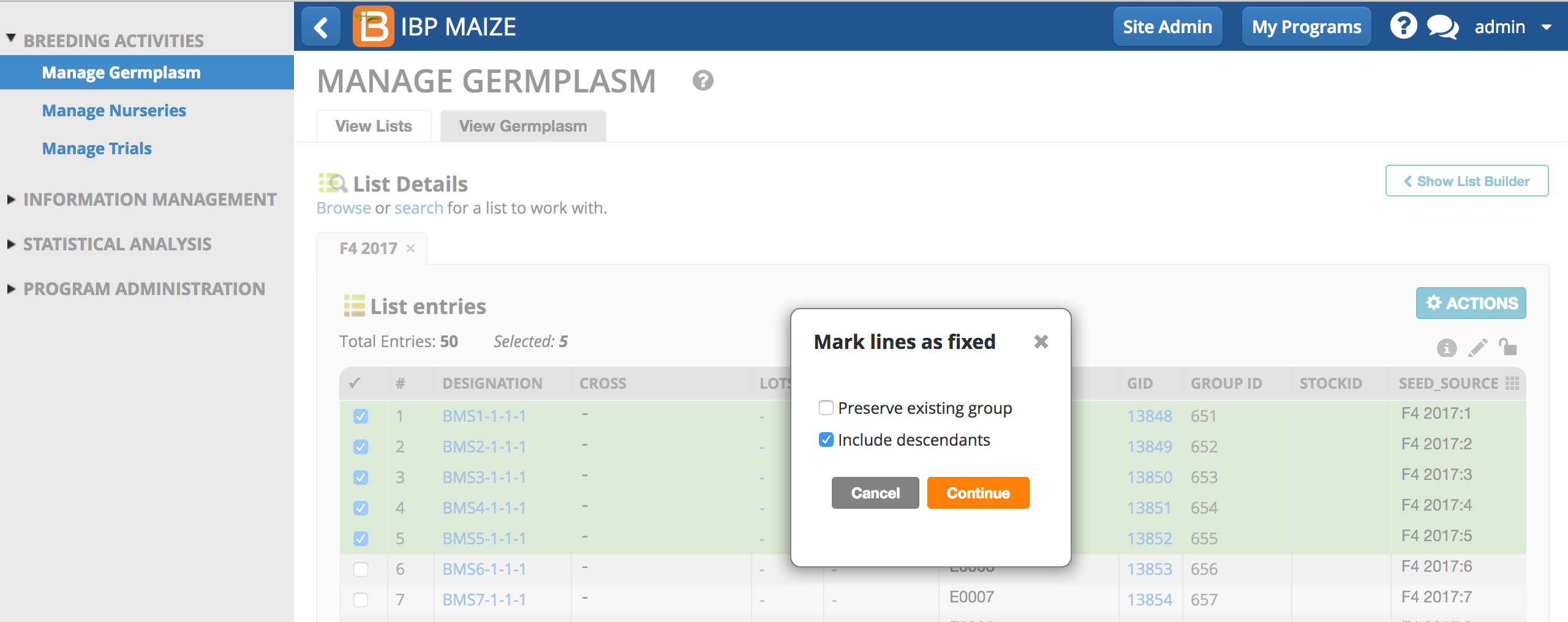
- Review the grouping results and select OK.

All entries received a new Group ID that will be inherited by the descendants.
The germplasm is now updated with a new Group ID.
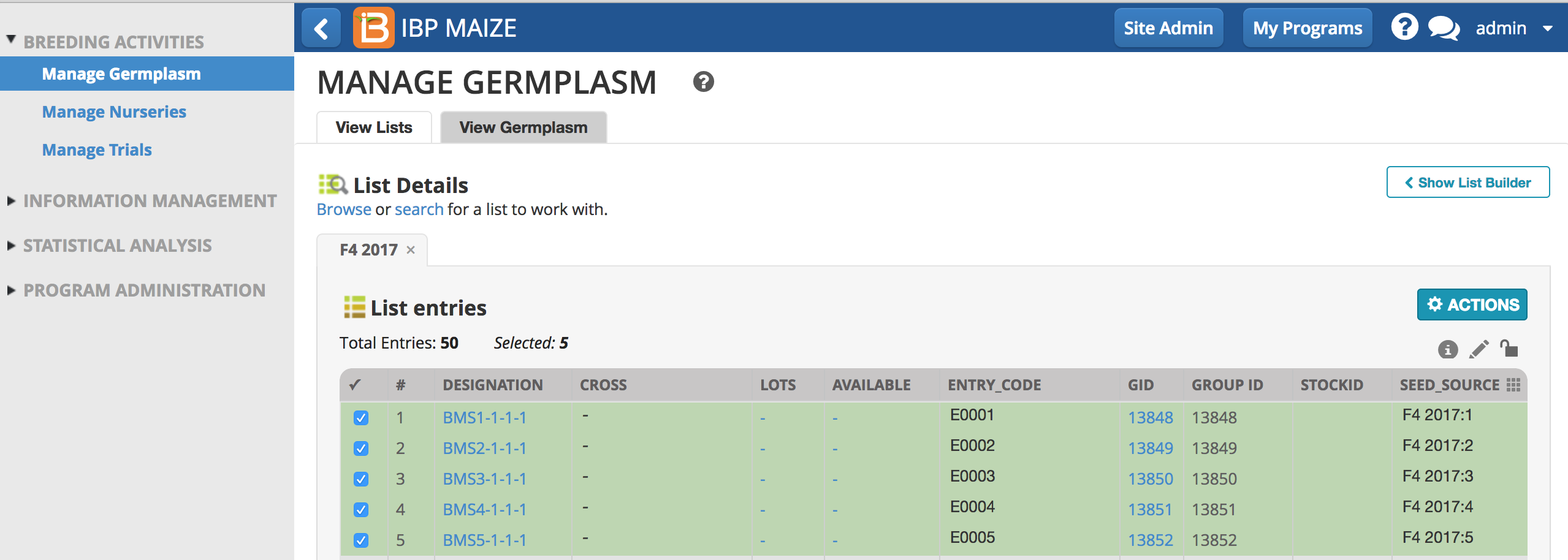
Code Grouped Lines
Codes are customizable names that can be assigned to grouped lines at different stages of line development, such as inbred line fixation and hybrid formation. Coded names become the preferred name for the lines, and are inherited as the preferred names of descendants in the same group. There are three levels of codes which can be assigned at different stages of development and each level supersedes the other as the preferred name for the group as it is assigned to any member of the group.
- From Manage Germplasm list view, assign codes to selected grouped lines from the Coding & Fixing Options of the actions menu.
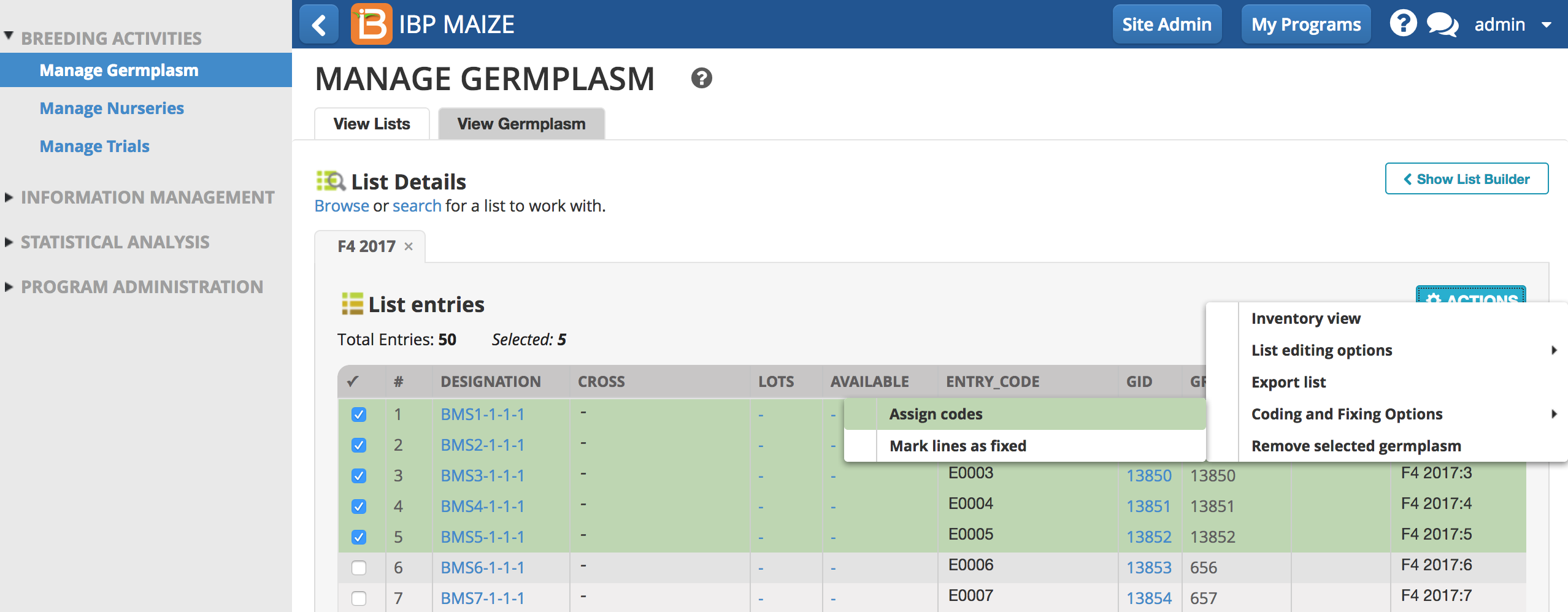
- Enter a code prefix to match the coding level and Apply Codes.
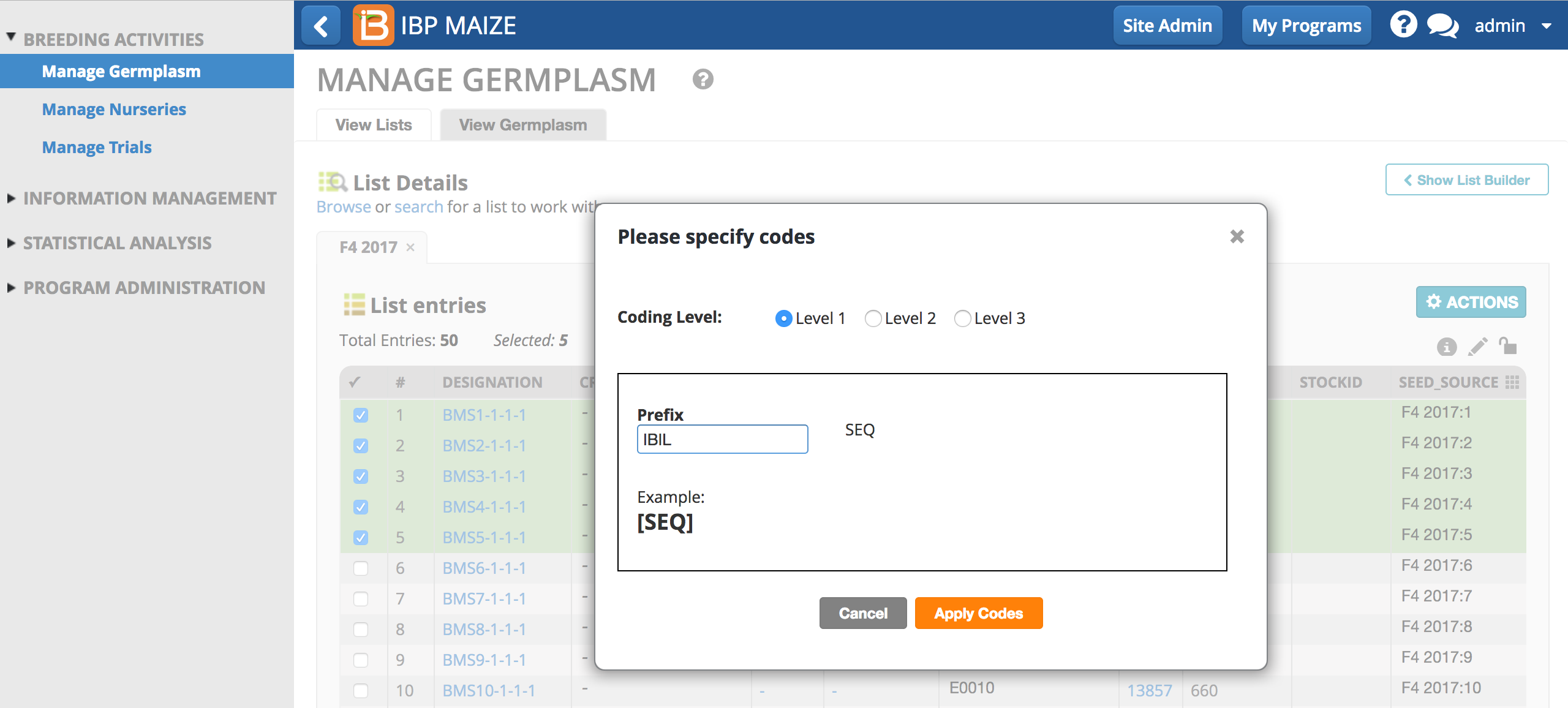
Coding Level 1 will be indicated by the IBIL prefix - which refers to the program, Integrated Breeding (IB) and the line type, Inbred Line (IL).
- Review the code results and select OK. Notice that the specified prefix has been concatenated with a sequence number to produce the code names.
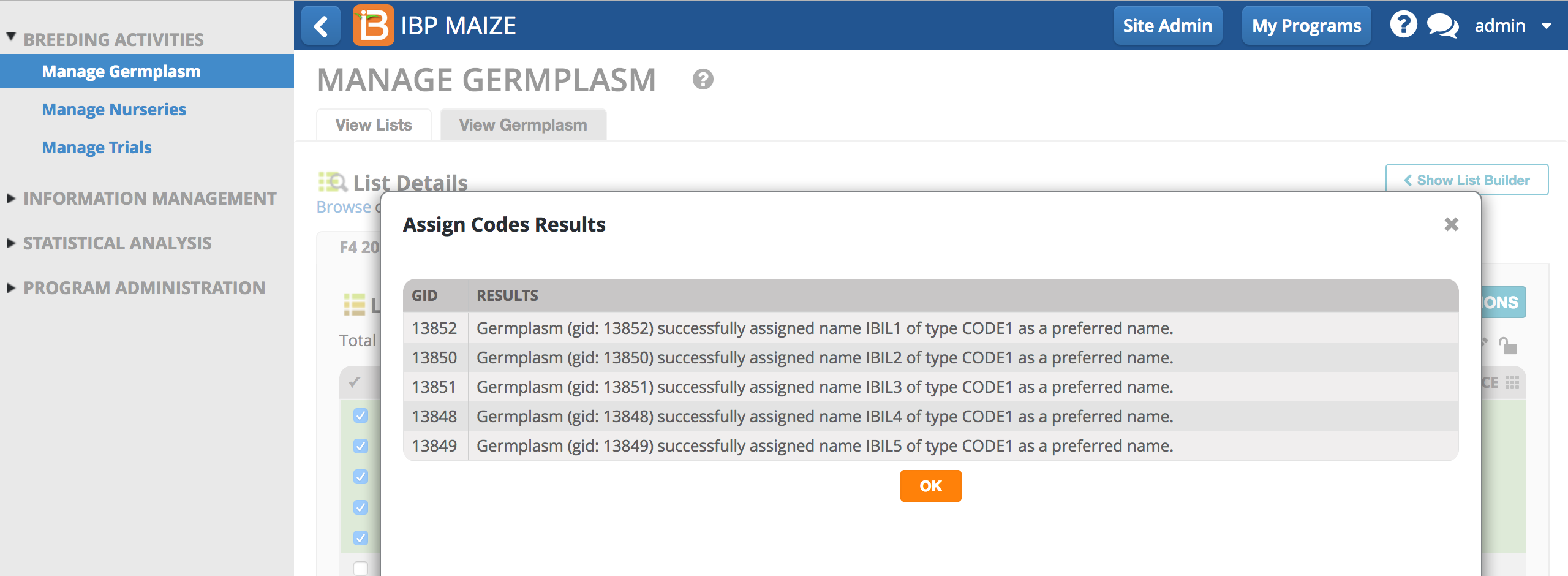
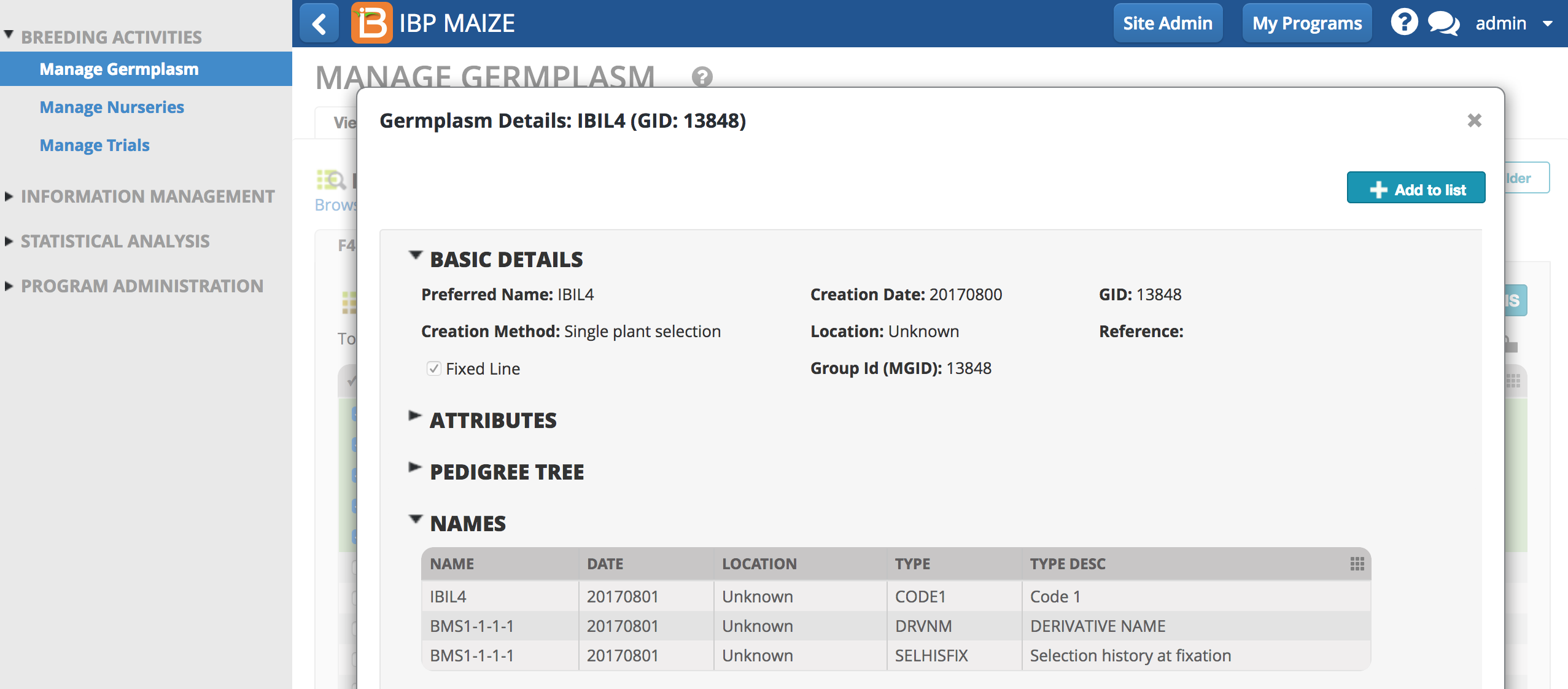
After fixing and coding, BMS1-1-1-1 is reported as a fixed line and has the preferred name, IBIL4, as conferred by Code 1.
- Reveal preferred coded name in the germplasm list. Right-click on ENTRY_CODE column heading and select Fill With Preferred Name.
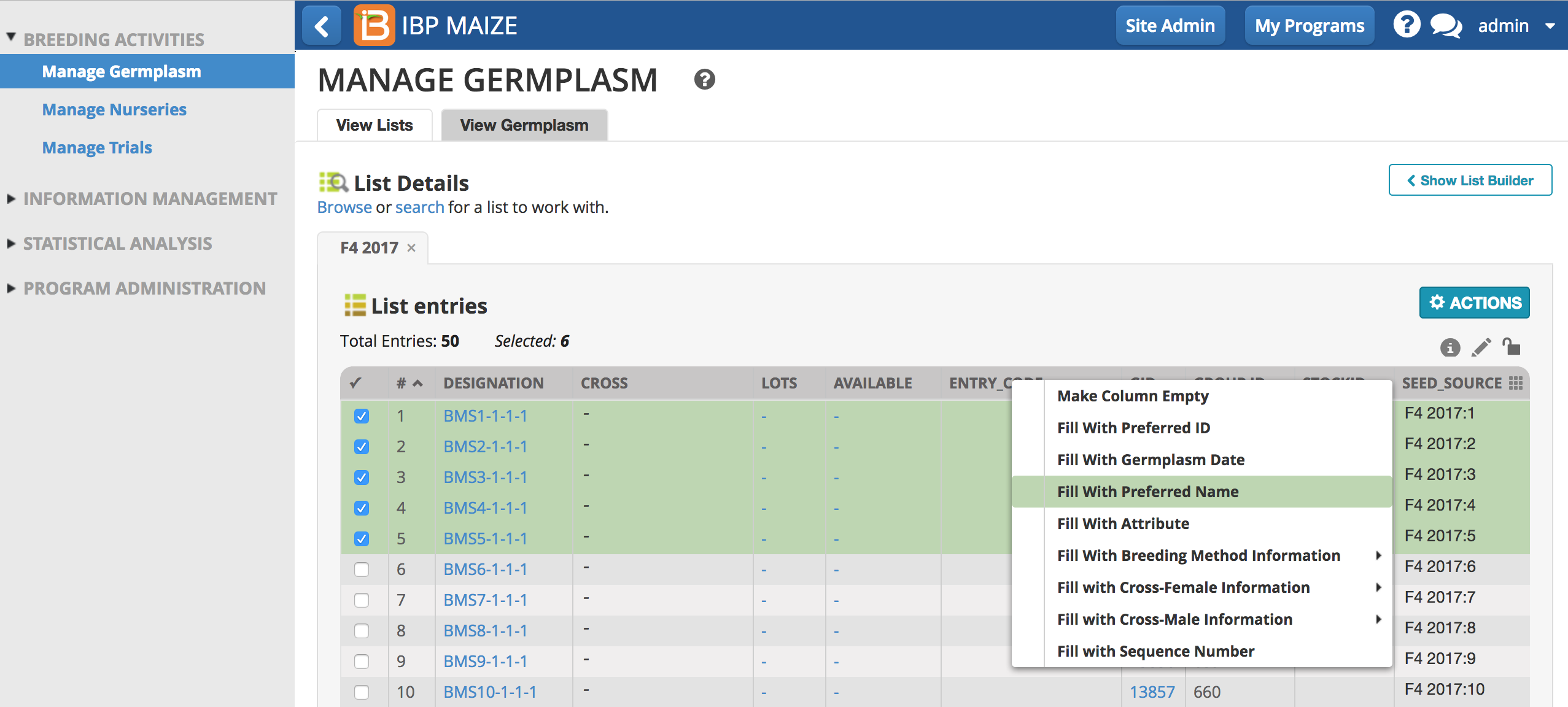
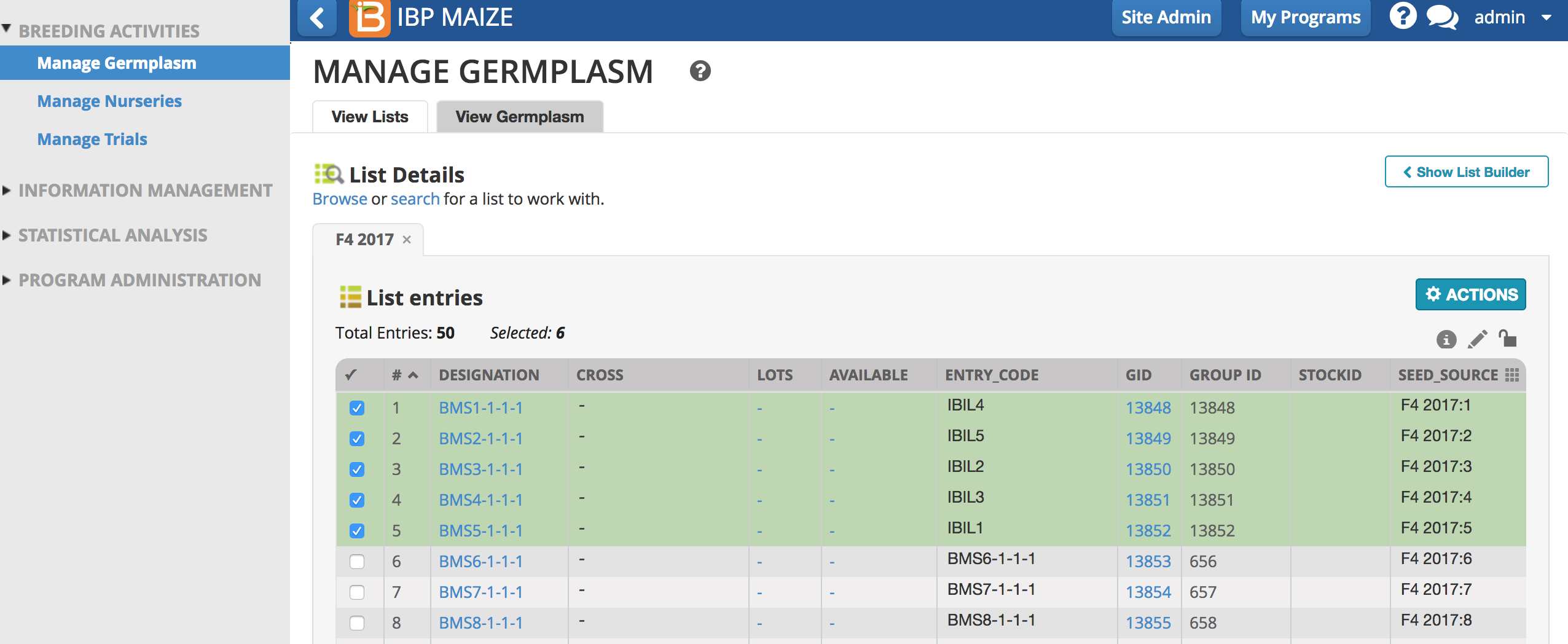
Hybrid Line Development
When grouped lines are used to create hybrids using hybrid breeding methods, the BMS will automatically group hybrid duplicates. So, all crosses between lines having the same male and female parental groups form a single group of hybrids.
The BMS has several default hybrid breeding methods for producing candidate or more advanced hybrids. The method IDs of these hybrid crossing methods are customizable in the file C:\BMS4\infrastructure\tomcat\webapps\Fieldbook\WEB-INF\classes\crossing.properties.
Default Hybrid Breeding Methods
| ID | Code | Name | Description |
| 321 | VHY | Hybrid formation | Forming a hybrid cultivar |
| 416 | TNL | Narrow based tester, line | Test (Top) cross between a known plant and a narrow based (1 or few plants) population. For practical reasons the tester population or line is used as the male which can be stored pollen. |
| 417 | TNP | Narrow based tester, pop | Test (Top) cross between a known population and a narrow based tester population. For practical reasons the tester population or line is used as the male which can be stored pollen. |
| 418 | TBL | Broad based tester, line | Test (Top) cross between a known plant and a broad based (many plants) tester. For practical reasons the tester population is used as the male which can be stored pollen. |
| 419 | TBP | Broad based tester, pop | Test (Top) between a known population and a broad based tester. For practical reasons the tester population is used as the male which can be stored pollen. |
| 426 | TCR | Test cross | Crosses made for generating hybrids for early generation testing. The females can be lines in any generation of inbreeding or DH lines, and the male is usually a fixed inbred line, or a F1 single cross between two fixed inbred lines. |
Cross Fixed Lines with Hybrid Methods
- Cross fixed lines with a hybrid method. Continue and save the cross list.
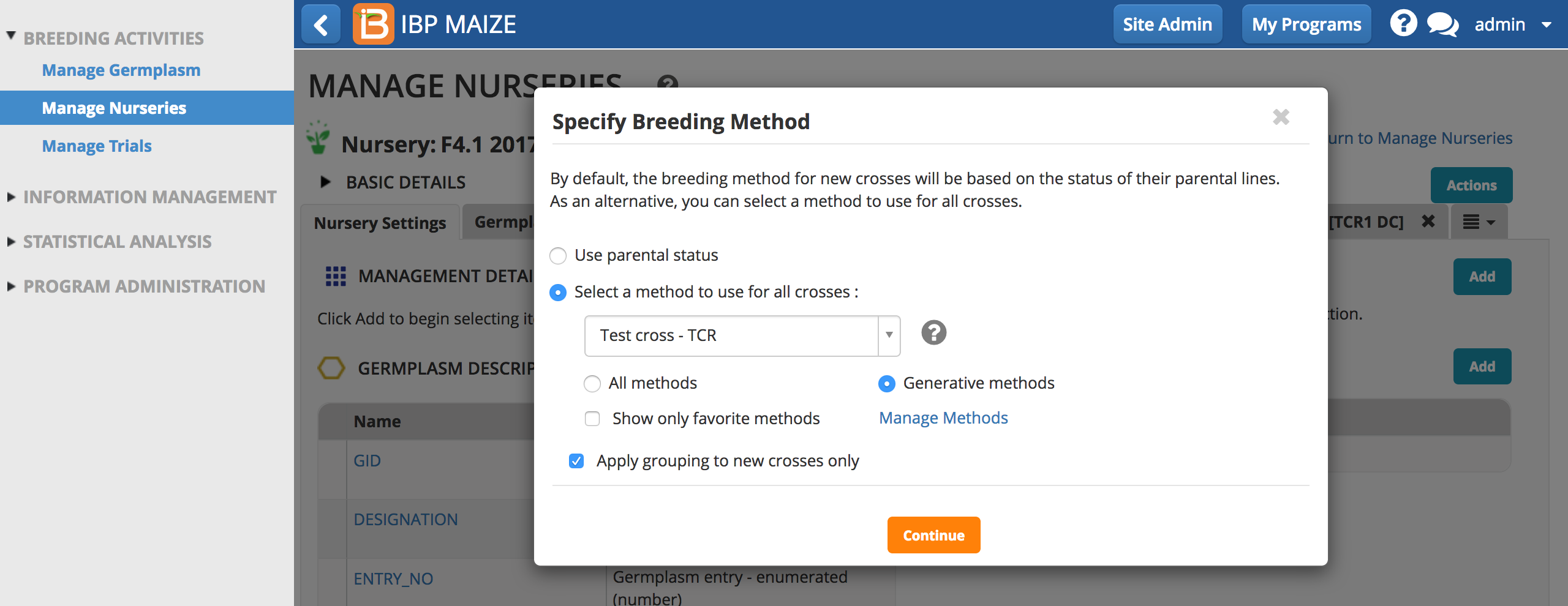
The resulting hybrids will receive a Group ID matching the parental groupings. Subsequent crossing of any member of the parental groupings, will result in hybrids with identical Group IDs. Hybrid grouping can also be coded (see above).
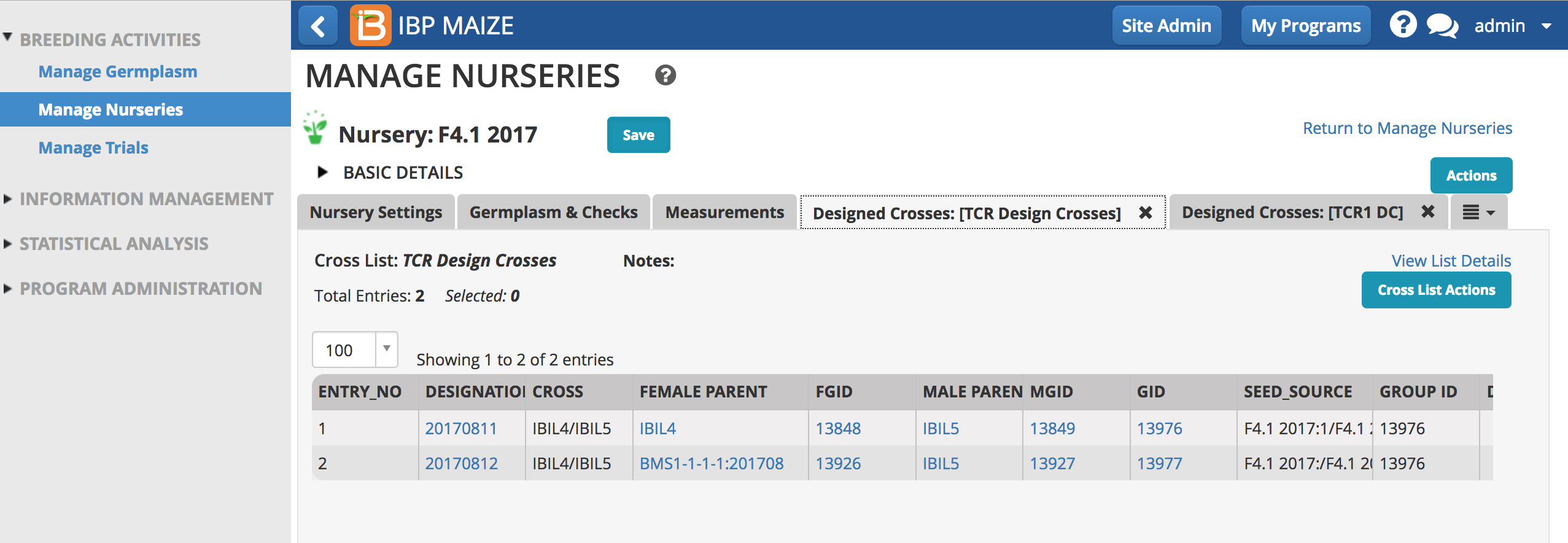
The parents of cross 1 & 2 have different GIDs, but the same GroupID. The parents of cross 1 are fixed F4 lines. The parents of cross 2 are grouped as the same fixed lines, except these are the result of an F4 seed increase. The hybrids have distinct breeding histories, but are grouped identically because they are considered genetically identical.


